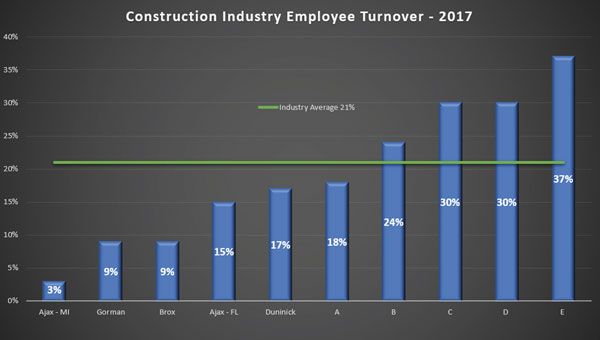In part one of this article, the cost of a departing employee, the cost of turnover, and what can be done to improve retention were discussed. We discussed how a study showed that losing a construction employee costs 16 percent of their annual payroll while an employee earning between $30,000 and $50,000 will cost 20 percent. It also showed losing a higher level manager or executive could cost 215 percent of their annual wages.
Part two covers how to maximize retention to keep good employees amidst the skilled workforce shortage. As stated in the first part of this article, the Industry Average for construction industry turnover was given by the Bureau of Labor Statistics (BLS) as 21 percent. Out of curiosity, I polled 10 industry clients and the results were amazingly similar, 19 percent. Check out the chart showing the results. Some clients requested to remain anonoymous.
MAXIMIZING RETENTION
According to The Society for Human Resource Management’s, “Job Satisfaction and Engagement” research report, most employees find the relationship with their immediate supervisor and senior management to be very important to their job satisfaction (“people leave their boss”). Specifically, employees want to feel respected, liked, and trusted by their superior. Included at the top of the list, additional strong contributors affecting job satisfaction included compensation, benefits, job security, job opportunities, and recognition.
Employee job satisfaction and engagement factors should be considered the key ingredients of employee retention programs.
If you want them to stay, understand what makes them happy. The importance of addressing these factors is generally well understood by most supervisors and managers. However, it takes time and effort and can be neglected from other duties and distractions. Here are some pointers from my personal experiences:
I work hard at practicing “1 in 7.” It is a recognition technique I discovered many years ago that shows employees appreciate some form of recognition (praise, pat on the back, atta-boy, acknowledgment) at least once a week. In other words, if you deliberately find something they did above average and acknowledge it weekly, they will feel like you don’t take their efforts for granted. It is important to remind yourself as it is easy to get distracted with all the obligations that mangers face. It is a responsibility to let them know, “Hey, I caught you doing something above and beyond and I want you to know I noticed, because I want you to repeat it.” 1 in 7 here and 1 in 7 there may seem small, but they add up.
Consider training your foremen, superintendents, and managers in contemporary leadership skills. The old ways of screaming and yelling don’t work for today’s workforce, especially when the unemployment rate is so low. Providing skills in modern methods of oversight can be a real winner when faced with the option of constantly facing replacing personnel on a crew.
Remember, the best companies hire for attitude and train for skill. Training has always been known to be a key contributor toward higher retention—use it. My folks spend years in training and coaching, and it never stops, because learning never stops. Conduct internal classes. Provide certificates of achievement for completion. A framed certificate may seem simple, but many will hang it as a reminder of their success. People want the confidence that the company cares enough about them to develop them.
Also consider conducting surveys, like work climate or attitude surveys, to find out how employees really perceive their job, benefits, manager, etc. A common and effective one is the Gallup’s Q12 Employee Engagement Survey, based on a study of thousands of organizations as to what keeps employees happily engaged in their enterprise. Find out what the issues are and address them. Is it pay, benefits, or supervision? You can’t address issues if you are unaware of them.
There is a difference between coaching and micromanagement. I like to coach but hate to micromanage. Hire the right people and set clear expectations, then get out of their way and let them do their job. But you still need to coach. Remember, delegation is not abdication. You still need to set clear expectations and provide feedback as to how folks are meeting expectations and standards. However, you don’t need to tell them how to do their job over and over. Help them to learn from their mistakes by debriefing what they should have done differently at the completion of a project. Get them into the habit of conducting an After Action Report or Debrief for Lessons Learned. What are the “repeatables” (to do again)? What are the “changeables” (need to alter while fresh in the memory)? Lessons learned can help them make refinements to their decision-making process. That is the difference between being the boss and being the mentor.
Remember, small gifts go a long way, such as gift certificates, lunches, a shirt, etc. It’s less about the value and more about the time you took to notice their contributions.
It is worth the time. The Return on Investment of focusing on employee retention is a capital investment effort. By mastering retention techniques, you increase performance, productivity, employee morale and quality of work, reduce turnover, and employee-related problems. It is well worth taking time and providing resources.
As Entrepreneur magazine says “study after study confirms that people have a deep desire to feel they’re succeeding and that their talents and capabilities are used in a way that makes a difference to the business. When people sense their actions are fulfilling this desire, they begin to develop a sense of belonging and a feeling that your company is their company.”
According to a 2008 Yukon Bureau of Statistics Business Survey, “workplaces that demonstrate the value they place in their employees and that put into place policies and practices that reflect effective retention practices will benefit, in turn, from worker commitment and productivity.”
Employees are our biggest assets—we can’t afford to let them go.
About the Author:
Preston Ingalls is president and CEO of TBR Strategies, LLC, a Raleigh, North Carolina-based maintenance and reliability firm specializing in the construction and oil and gas industries. Preston can be reached at pingalls@tbr-strategies.com, or visit www.tbr-strategies.com.
_________________________________________________________________________
Modern Contractor Solutions, March 2018
Did you enjoy this article?
Subscribe to the FREE Digital Edition of Modern Contractor Solutions magazine.




